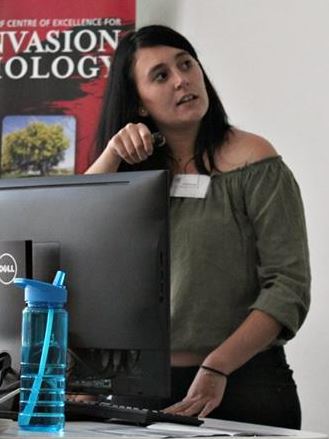Doctoral Students
Evaluating the effects of changing global climate on herpetofaunal (amphibians and reptiles) functional groups of South Africa, using physiologically determined mechanistic modelling approach Global climate has warmed by about 0.6°C on average in the last century and this trend is expected to continue. In response to these changes, species have been reported to: i) shift their distribution ranges, ii) their time activity (phenology) or, iii) have become locally extinct. Thus, to mitigate against the predicted effects of climate change, we need to accurately predict the response of our most vulnerable fauna (ectothermic vertebrates: reptiles and amphibians). Little is known on how future changes in climate systems will affect South African vertebrate ectotherms. Thus, using a multi-disciplinary line of evidence, the aim of this study is to synergise data from multiple lines of evidence (physiological, performance and ecological) and synergise them into Species Distribution Models (SDMs) to aid in the responses of different functional groups of South African ectothermic vertebrates to climate change. This study will produce a suite of mechanistic models for functional groups of ectothermic vertebrates in South Africa to make more reliable predictions on the shifts of biological communities in response to climate change. Years: from 2013 Stellenbosch University Invasive Indian Bullfrogs on the Andaman Islands The Indian bullfrog, Hoplobatrachus tigerinus, naturally occurs in the Indian sub-continent and Sri Lanka. Introduced populations of the bullfrog, localized to a few areas, were reported recently (2009-10) from the Andaman Islands. The bullfrog has a potential to become invasive in these tropical islands which also harbour a high proportion of endemic biodiversity. The bullfrog’s large size, generalist diet, breeding vigour, and synanthropic nature confer it with an ability to outcompete and predate heavily on native anurans and other vertebrates. My doctoral study aims to assess the extent and drivers of the bullfrog’s invasion, its impact, and effective management scenarios for its eradication. The findings of the study would provide management action worthy inputs, such as, pathways of introduction and spread. Given that the Andaman Islands are a global biodiversity hotspot, several endemic species could potentially be safeguarded through management action based on the findings. In tandem with a growing national concern on invasive species in India, the findings of the study would contribute to formulating a general strategy for preventing invasions into island ecosystems of the country. From 2016 Stellenbosch University Are tadpoles limiting the invasion of the African Clawed Frog? Biological invasions are a major threat to biodiversity and ecosystem services on a global scale. One challenge is to anticipate the invasive potential of populations when introduced in a novel area and identify key parameters that may limit their spread. Climate-based models are limited as they cannot always identify the actual biophysical limits, especially for species with complex life cycles. For these species, most existing biophysical data is for adults while it may be larvae which are limiting distributions. It is therefore a challenge to collect relevant data and develop integrated ecological and evolutionary studies and distribution modelling which can elucidate the limitations of different life stages of invasive species. This PhD project focuses on the evolutionary responses at the larval stage of X. laevis in invaded areas of France and within the native range in South Africa. The approach is primarily experimental (in both France and South Africa) with supporting field-work. Data analysis and writing manuscripts for publication will be ongoing from first results. From 2017 Stellenbosch University & University of Lyon Co-supervised by Jean Secondi - U. Lyon

Mohlamatsane Mokhatla

Nitya Mohanty
Natasha Kruger
